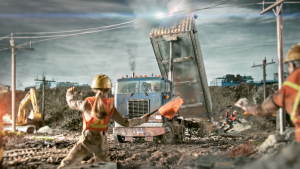
Increasing powerline safety: A shared responsibility
By Scott Saint
Health & Safety powerline safety safetyThe scene could be reconstructed at any worksite: a worker stands to the side of a dump truck as it pulls away from a newly dumped pile of gravel. As the driver moves forward, the box of the truck contacts the overhead powerline. The truck and the area surrounding it become energized and a co-worker collapses on the ground.
The powerline contact was fatal.
Working near powerlines is an inherently dangerous endeavour, but over time it’s easy to get accustomed to it and forget the danger. The details of a spring safety talk on powerlines can fade by the time September rolls around. Yet the danger remains.
Each day, thousands of construction workers go about their business working with machines alongside powerlines that could kill or injure them in an instant. Direct contact can be fatal, but even without direct contact, electricity can arc or “jump” to you or your equipment if you get too close, and can be fatal.
At the Electrical Safety Authority (ESA), we see the horrifying consequences of incidents involving powerlines. According to the Ontario Electrical Safety Report (OESR), from 2006-2015, there were 1,338 reported powerline contacts in Ontario. Many more go unreported. Twenty-three of those contacts resulted in a fatality and many more in crippling injury. This data does not account for the impact on a site for co-workers or family members, whose lives are irreversibly changed.
At ESA, we’ve made it one of our key goals to stop powerline contacts in Ontario from happening. We use our insights, expertise and passion for safety to guide us. But we can’t do it alone. We need everyone – the construction industry, local utilities, safety partners, workers and their families to join us in the effort to make sure everyone comes home safely, each and every day.
The OESR also indicates that 70 per cent of powerline contacts take place on construction sites, with dump trucks being the leading offender. Knowing this, it’s essential that others in the electricity sector, construction industry and trades turn our collective focus to powerline safety.
It’s clear there are dangers on the worksite; the question is what we can do about them? The good news is that there are three simple, effective methods for dramatically reducing the risk of powerline contact on the worksite. While these practices were developed with dump truck operators in mind, the principles apply to all high reach equipment.
Look up
When setting up equipment, look up and make note of all powerlines in the area. It is good practice to load and unload all materials away from overhead powerlines. Even better, it is recommended to create a dedicated drop zone away from all overhead powerlines.
When equipment absolutely has to operate near powerlines, the local utility should be called to de-energize the line in question. The only safe powerline is one that has been shut off.
Signallers are an operator’s extra set of eyes*
There are limitations to an operator’s field of vision when they’re on a job site; they simply can’t see everything. In Ontario, regulations require that a competent signaller be stationed so that they are in full view of the operator and equipment so they can warn if the equipment gets too close to a powerline.
The signaller should be 10 metres away from the equipment at all times to ensure they are not within the energized area in the event of a powerline contact.
Lower the box before moving the truck*
This tip is specific to dump trucks, but it’s an important one as we’ve seen a significant increase in contacts involving dump trucks. Once a load of material has been dropped, the box should be lowered. Some dump truck operators have installed raised box indicators, but workers in the area (and the dedicated signaller) should be ready to warn drivers when their box is raised.
It’s also essential that workers know what to do in the event of a powerline contact, including staying in the vehicle until the power is turned off, calling 911 right away, and making sure everyone else on the site – including emergency first responders – stay at least 10 metres back. This knowledge can save a life.
ESA has collaborated with our safety partners to create a Powerline Safety Best Practice for Dump Truck Operators as well as other important materials to help inform workers and the public about what to do in the event of a powerline contact and how to avoid the hazard. This information and more is available at esasafe.com/powerlinesafety.
Electricity is among the most powerful tools we have at our disposal, but there are tragic consequences if we don’t respect the power. We are all responsible for making sure that worksites are safe for ourselves, our colleagues and the general public.
*Occupational Health and Safety Act and the Regulations for Construction Projects (O. Reg. 213/91)
Scott Saint is Chief Public Safety Officer at the Electrical Safety Authority. Send comments to editor@on-sitemag.com.





